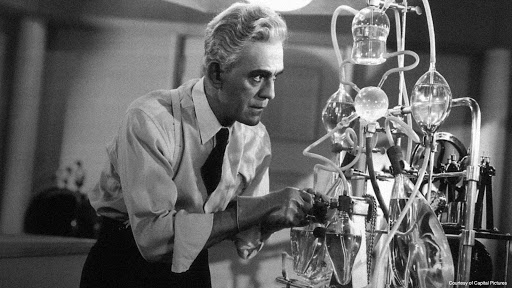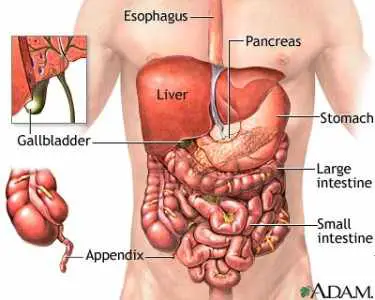The Top 5 Largest Organs in the body
| Organ | Average weight | |
|---|---|---|
| 1 | The Skin | 10.8 kilos (10895.10 grams) |
| 2 | The Liver | 1.4 kilos (1493.79 grams) |
| 3 | The Brain | 1.3 kilos (male)/ 1.2 kilos (female) |
| 4 | The Lungs | 579.75(lt)/ 531.92(lt) Total weight: 1.1 - 1.3 kilos |
| 5 | The Heart | 289 grams (male)/ 241grams (female) |
 Special Report
Special Report
What you'll learn:
The Skin is Our Largest Organ? Really?
Yes. Not only is it the body's largest organ, but the skin is also the body's largest and fastest-growing organ. Skin covers 22 square feet or 2 square meters of the human body in a full-grown adult and is completely replaced around once per month. The skin is part of a complex system called The integumentary system, which is an organ system that contains all the fun stuff like your skin, nails and hair.
If you could unzip your skin and take it off like a coat (as fun as that sounds, we do NOT recommend you do that), it would weigh around 9 kilograms or 20 pounds. However, recently, some scientists and researchers say that a newly discovered "organ", called the interstitium, a kind of connective tissue under our skin and found between other organs, may well be the "new" largest organ in the body. For our top 5 list though, we are sticking with the skin as the largest organ until all the definite research is in.

The Amazing Liver
The liver is the largest internal, and most metabolically complex, organ in humans. It's pretty incredible. The liver performs over 500 different functions including fighting off infection, neutralizing toxins, manufacturing proteins and hormones, controlling blood sugar and helping to clot the blood. The liver is the only internal organ that can regenerate itself, thus making it possible for one person to donate part of their liver to another person.
When a portion of the liver is transplanted, the donor's liver will regenerate back to its original size while the transplanted portion will grow to the appropriate size for the recipient. As the second-largest organ, the liver can weigh up to 1.5 kilos and acts as a large filter eliminating toxins from the blood.
The Organ that Allows Us to Think about Organs
The brain is the third largest organ on our list and makes up about 2% of a human body’s weight but uses 20% of its total energy and oxygen intake. Your brain is 73% water. It only takes 2% dehydration to affect your attention, memory and other cognitive skills; so don't forget to drink lots of water. Twenty-five percent of the body’s cholesterol resides within the brain. Cholesterol is an integral part of every brain cell so without adequate cholesterol, brain cells die.
Researchers estimate that our brains contain roughly 86 billion brain cells. A piece of brain tissue the size of a grain of sand contains 100,000 neurons and 1 billion synapses all interconnected and communicating with each other. Not only is the brain one of the largest organs in the human body, but it is also certainly the most complex.
“The human brain has 100 billion neurons, each neuron connected to 10,000 other neurons. Sitting on your shoulders is the most complicated object in the known universe.” - Michio Kaku
The Stealing of Einstein’s brain
Probably the most famous brain in the world is Einstein’s brain. It was so famous in fact, that the pathologist who was conducting the autopsy decided to steal it and carry it around with him for the next 40 years. Apparently, Einstein didn't want his body (or brain) studied or kept anywhere. His wishes were to be cremated because he thought that leaving any part of his corporal self in the world after death would lead to people worshipping or idolizing his dead body or parts of it, especially his brain. It looks like he was right about that. In any case, the pathologist, whose name was Thomas Harvey, decided he couldn't bear that the brain be wasted, and, against Einstein's wishes and the wishes of his family, on April 18, 1955, he took the train home from work. Over the next 40 years, while moving from place to place, Harvey kept Einstein's brain and stored it in jars in cardboard boxes until a journalist tracked it and him down in 1978. He stole Einstein's eyeballs too, but that's another story told here, in Michael Paterniti's excellently entertaining book: Driving Mr. Albert: A Trip Across America with Einstein's Brain (G.). Warning! Trust us, once you start reading about Einstein's brain and it's a bizarre journey, you won't be able to put the book down.
The Incredible Human Lung
Human lungs, the fourth largest organs in the human body, are the only organs that can actually float. The total length of the airways running through the two lungs is 1,500 miles or 2,400 kilometres. The two lungs together contain 300 to 500 million alveoli which are teeny-tiny air sacs in your lungs that absorb the oxygen you breathe in and exchange oxygen and carbon dioxide and pretty much keep you alive. There are about 600 million alveoli packed into your lungs.
Scientists estimate that the total internal surface area of lungs in adult humans vary between 30-50 sq. meters and 70-10 sq. meters. The total internal surface area of the human lungs is estimated to be equal to the total area of one side of a tennis court. An average person breathes in 8,000 and 9,000 litres of air per day. The worst thing you can do to your lungs is smoke cigarettes. Smoking causes 84% of deaths from lung cancer and 83% of deaths from chronic obstructive pulmonary disease (COPD), which are diseases that directly affect the lungs and respiratory system. lungs pretty much tell smokers everything they ever needed to know about tobacco the very first time they smoked. What happened was, their lungs coughed, as if to say "GET THIS Cr@! OUT OF HERE!" So if you are a smoker, you should listen to your lungs because they know what's bad for them.
The Body's Pump
The human heart, the fifth and final organ on our top 5 list, performs an awful lot of work for an awfully long time considering it is constantly going for 70 or 80 years on average depending on how long you live. So it has to be an extremely reliable pump if it's to keep you alive for all those years. The heart beats about 100,000 times per day, sending 2,000 gallons (7,570 litres) of blood surging through your body. A normal heart valve is about the size of a half-dollar and generally speaking, a healthy heart is about the size of the person's fist. The force it takes you to squeeze a tennis ball is the same it takes your heart to pump blood around your body.
Besides all that. the human heart is probably the most famous organ in literature and pop culture. Seriously, nobody writes songs about your lungs, even though your lungs are just as important. No other organ or body part shows up in songs, poems, tattoos, books, movies, etc then the human heart. The heart gets all the attention. Bet you never thought about that before.
The First Successful Organ Donation and Transplant
In December of 1954, the very first successful human kidney transplant was performed by Dr. Joseph E. Murray and his team at Peter Bent Brigham Hospital in Boston, Massachusetts. The transplant was performed on identical twins Richard and Ronald Herrick, with Ronald being the first-ever organ donor.
Ronald's twin brother, Richard Herrick, was suffering from chronic kidney failure, a disease that, in the 1950s, was considered to be an eventual death sentence. Ronald was desperate to save his brother's life and offered up one of his kidneys for donation. The fact that the brothers were identical twins was a positive factor in the face of organ rejection and one of the reasons why the pioneer medical procedure went ahead in the first place.
The operation was extremely risky for both brothers. While Richard faced the possibility of complete rejection of his brother's organ, Ronald faced complications from general anesthesia, hemorrhage, possible accidental injury of a nearby vital organ, and serious infection among other risk factors. It was a heroic and fearless thing to do on his part, and it was all for the love of a brother.
The Brothers Risk it All
Despite the incredible risk, sacrifice and technical difficulty, the complex multiple surgeries began at 8:15 on the morning of December 23, 1954. One hour and 22 minutes later, the procedure was complete and Dr. Murray and his team had performed the first successful human organ transplant. Richard Herrick lived for another 8 years after the surgery and died in 1963 while his donor brother Ronald died at the age of 79 in 2010 from heart complications. Dr. Murray went on to win the Nobel Prize for medicine in 1990 and died at the age of 93 in 2012. (c.)

Organ Donation Statistics in the United States
In the United States in 2019, there was a total of 7,397 living donors. According to the Mayo Clinic, a living-donor transplant is a transplant surgical procedure to remove a healthy organ or portion of a healthy organ from a living person and place it in another person whose organ is no longer functioning properly. (d.)
39,718 organ transplants were performed in 2019, a record year. Out of those 7,397 were living donors who donated an organ to others in need.
In 2019, around 62% of organ recipients were male and 38% of organ recipients were female. As of March 2020, more than 112,000 candidates are waiting for an organ transplant on the U.S. national organ transplant waiting list. Around 2,000 of those are children, while 2 out of every 3 people on the U.S. national organ transplant waiting list are 50 years old and over. (e.)
The Countries that Donate the Most Organs
Spain is the country with the highest rate of organ donations. The United States comes in second on our top 5 list. Spain runs an "opt-out" organ donation system, which means if a person doesn't wish to be an organ donor they have to "opt-out" and register as a person who doesn't want their organs donated. This is usually the opposite in other countries where people normally sign a "consent" form specifically saying they want to be an organ donor. Many countries are starting to follow the Spanish model because of its enormous success. In Spain, in 2018 there were 5,570 transplant surgeries, with 63% of those being kidney transplants and 22% being liver transplants both from deceased donors.
Hope you enjoyed this list as much as we did create it for you!
Noel James Riggs, Madrid.
Top 5 facts sources:
B. Murray, Joseph E. (2020), Retrieved from: “ The Fight for Life"
C. Top5ofanything.com Research 2020.
D. Mayo Clinic. (2020), "Living-donor transplant".
E. Organdonor.gov, (2020), “ Organ Donation Statistics "
F. UConn Today. (2018). "The Most Complicated Object in the Universe."
G. NPR. (2005). "The Long, Strange Journey of Einstein's Brain."
Sources: Top5ofanything.com research 2021: the data in this list was researched from medical sources including Gray's Anatomy 41st edition.
List Notes:
Data is the top 5 largest organs in the human body ranked according to weight. Please note that weights of individual organs can vary.
Please note: despite the fact that the top5ofanything.com lists the skin as the largest organ in/on the human body, in the interest of opposing viewpoints by experts, we encourage visitors to please consider this article published by the "Journal of Investigative Dermatology": " Skin Is Not the Largest Organ. " Recent research also suggests that the interstitium, a new "organ" may be vying for the crown as the human body's largest organ, but more research and study is needed and the Top 5 of Anything will definitely keep you posted if anything changes.

